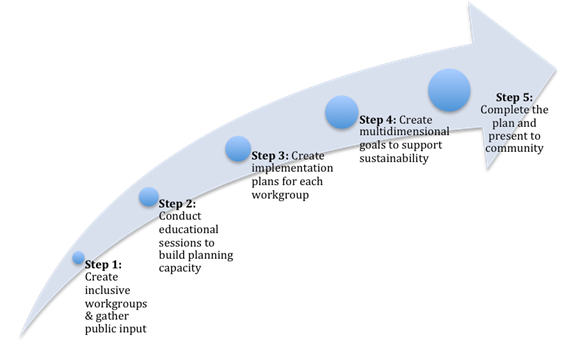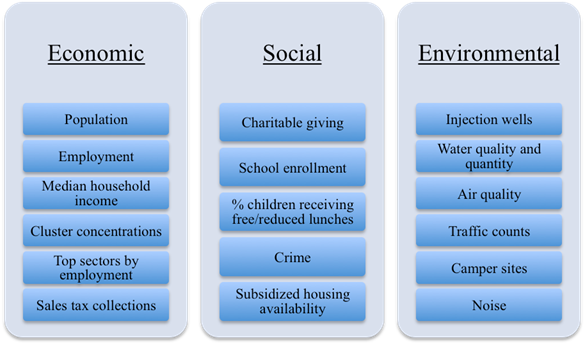 |
June 2015
|
June 2015 // Volume 53 // Number 3 // Ideas at Work // v53-3iw1
Building Sustainability in Gas- and Oil-Producing Communities
Abstract
Extension can play a significant role in addressing the rapid development and associated impacts that can occur in oil- and gas- producing communities. Through quantitative longitudinal analysis and research-based sustainable planning, Extension can assist rural communities in Ohio to be better equipped to maximize resources, manage change, and make informed decisions affecting their residents. This article provides a framework for an effective program focused on shale development planning and offers a context for massive change taking place in rural communities across the nation.
Introduction
Growing domestic production of oil and gas from tight shale formations is affecting rural communities throughout the nation. More than 15 states currently host oil and gas operations, and others prepare for the industry. As a result of shale energy development, projections suggest "the United States will overtake Saudi Arabia as the world's biggest oil producer by around 2020" (IEA, 2012, p. 1).
Shale energy development affects the economic, environmental, and social sectors of community. According to Farren, Weinstein, and Partridge (2012), "previous energy booms provide countless historical examples that show, in general, a contraction will follow an economic expansion" (p. 9). Meanwhile, social impacts include housing, cost of living, crime, roads, and strains on public services (Schafft, Borlu, & Glenna, 2013). Associated environmental impacts include impacts to climate, local air quality, water availability, water quality, and seismic events (Clark, Burnham, Harto, & Horner, 2012).
Extension is viewed as a leader in disseminating reliable energy information (Iams, 1984). Since 2010, OSU Extension has delivered more than 200 shale energy programs reaching 16,000 participants. Initial efforts addressed individual landowner needs for legal and financial education, while subsequent efforts transitioned to community-based issues. This article presents a sustainable community planning process designed to help communities address the short- and long-term economic, social, and environmental impacts of shale development (Figure 1).
Figure 1.
Sustainable Planning Process

Building Planning Capacity in Shale Rich Communities
Extension is recognized for its role in guiding community plans that build local capacity to address social, economic, and environmental goals (Blaine, Moss, Cummings, & Myers, 2013).
With grant support from the North Central Regional Center for Resource Development (NCRCRD) and the U.S. Economic Development Administration (EDA), OSU Extension developed a sustainable planning model for communities affected by shale development. The NCRCRD grant is supporting a pilot initiative in the heart of the Utica play (Guernsey County), and the EDA grant is supporting the application of this model on a regional scale, encompassing 25 counties in Eastern Ohio. These initiatives, although different in geographic scope, include the following common elements.
- Both encompass geographic areas affected by shale development. One scale is regional, while the other is county-based. Lessons learned at the county level will inform the application of the model regionally.
- Both engage community/regional leadership, resulting in unique collaborative partnerships. In Guernsey County local planning and economic development committees took the lead, with involvement from diverse organizations representing values of environmental, economic, and social sustainability. Through the EDA project, four regional economic development districts and their broad-based advisory boards are collaborating partners.
- Both initiatives build upon existing planning documents, including regional comprehensive economic development strategies (CEDS) and a county-based comprehensive plan. In both cases, the plans had few references to shale development, an indication of how quickly this wave has swept over Eastern Ohio.
- Both implement planning initiatives incorporating the cornerstones of sustainability, which include Inclusion, Balanced/interconnected, Long-term, and Multidimensional.
Implementation and Preliminary Results
The implementation of the Guernsey County sustainable planning process pilot has accomplished the following.
- Inclusive: Workgroups were established around social, environmental, and economic impacts, including housing, economic development, workforce, education, infrastructure, and agriculture. These workgroups were tasked with gathering community input on short-term challenges and desired long-term benefits. Common themes from aggregated input were posted to a project Web site and used to guide goal formulation and implementation plans.
- Balanced/Interconnected Education: Educational sessions were held to set the stage for sustainable planning and present short-and long-term impacts of shale energy development (Table 1). The final session interconnected the social, economic, and environmental impacts into a sustainable framework. Sessions were held 60 days apart to allow workgroups to incorporate knowledge gained into their plans.
| Planning Session | Brief Session Description | Session Design/Speakers | Evaluation Results |
| Shale Development 101 (Project Launch) | Introduce purpose of sustainable planning process, review shale energy development and community impacts | OSU Extension presented the shale energy overview and facilitated the participants in identifying social, environmental and economic issues |
|
| Social Sustainability | Identify anticipated social impacts and possible resources, strategies, and best practices | Facilitated panel discussion with impacted landowners and shale industry representatives | Comments to open ended questions:
|
| Environmental Sustainability | Identify anticipated environmental impacts and possible resources, strategies, and best practices | Panel presentations and discussion from the Ohio Department of Natural Resources, industry representatives and OSU environmental experts | Pre-post knowledge questionnaire:
|
| Economic Sustainability | Identify anticipated economic impacts, review research results from economic impact analysis, and help local leaders develop strategies to prepare for a sustainable future | Capstone speaker from Penn State and a presentation and discussion on the economic cluster analysis from OSU Extension | 5 Point Scale Used:
|
| Creation of Sustainable Growth Management Chapter and Final Plan | Share each workgroup's plan to formulate shared planning issues that tie together and formulate consensus planning priorities and planning issues to build sustainability | Presentations by workgroup chairs and OSU Extension facilitated the development of shared planning issues and priorities based on multidimensional goals | Observation and Session Outcomes:
|
- Building Long-Term Multidimensional Goals: A final planning session was held to bring each of the workgroups together to review each other's sector plans and develop long-range comprehensive planning issues, supported by shared planning priorities that link together the workgroup's social, economic, and environmental goals. These multidimensional goals will be featured in the "capstone" growth management section of the plan and will be used to help community organizations and local leaders recognize their place and role in moving the plan forward.
Next Steps—Replicating the Model on a Regional Scale
The EDA project is replicating the Guernsey County model to leverage manufacturing clusters from local shale energy assets using a sustainable strategic planning approach. The team began working in partnership with the four regions in January 2014 to begin the initial steps of this three-year grant-funded project.
Activities can be summarized into two categories for the EDA project: 1) economic analysis and 2) sustainable planning process. At the time of this publication OSU Extension has:
- Established partnership and workgroups to layout the project,
- Organized internal social, environmental, and economic workgroups to conduct research and develop programming,
- Identified and organized raw data to conduct the economic analysis, and
- Conducted a total of eight workshops to disseminate research findings and initiate the planning process.
Modeling the Guernsey County project, the team is tracking change indicators (Figure 2) for the economic, environmental and social complexities of each region. Indicators are being and measured and reported to the regions every six months during the project.
Figure 2.
EDA Project Change Indicators

The project also entails an investigation of existing shale energy planning processes throughout the country and beyond. This research will inform strategies that have been applied in other communities. These efforts will also assist with future research related to the impacts of the mining mega-cluster and how these impacts can be affected to benefit and sustain local economies. There is growing interest in the model being developed in Ohio. Five other states have been in contact with the OSU Extension team to learn about the process as it unfolds and how it is working. As the model is further developed, the team continues to put emphasis on sharing with and learning from other states in an effort to build a consortium for the pooling of knowledge, resources and best practices related to maximizing the potential of shale energy development.
References
Blaine, T., Moss, M., Cumming, J., & Myers, J. (2013). Comprehensive land use planning in exurban communities: A case study from Ohio. Journal of Extension [On-line], 51(5) Article 5RIB5. Available at: http://www.joe.org/joe/2013october/rb5.php
Clark, C. E., Burnham, A. J., Harto, C. B., & Horner, R. M. (2012). INTRODUCTION: The technology and policy of hydraulic fracturing and potential environmental impacts of shale gas development. Environmental Practice, 14(4), 249-261. Retrieved from: http://dx.doi.org/10.1017/S1466046612000415
Farren, M., Weinstein, A., & Partridge, M. (2012). Making shale development work for Ohio. [Policy Summary Report]. Columbus, OH: Ohio State University. Retrieved from: http://aede.osu.edu/sites/aede/files/publication_files/Making%20
Shale%20Development%20Work%20for%20Ohio%20June%201.pdf
Iams, D. R., & Wilhelm, M. S. (1984). The public's view of energy education. Journal of Extension [On-line], 22(6) Article 6FEA2. Available at: http://www.joe.org/joe/1984november/a2.php
International Energy Agency (IEA). (2012). World energy outlook 2012. Retrieved from: http://www.worldenergyoutlook.org/publications/weo-2012/
Schafft, K. A., Borlu, Y., & Glenna, L. (2013). The relationship between marcellus shale gas development in Pennsylvania and local perceptions of risk and opportunity. Rural Sociology, 78(2), 143-166.




